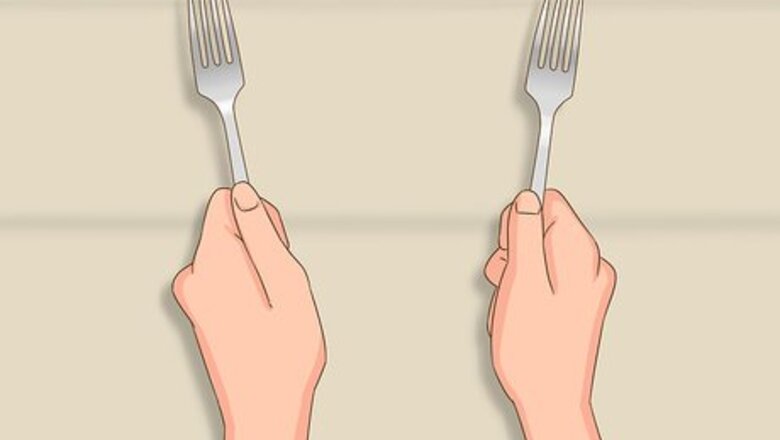
views
Eating With A Fork
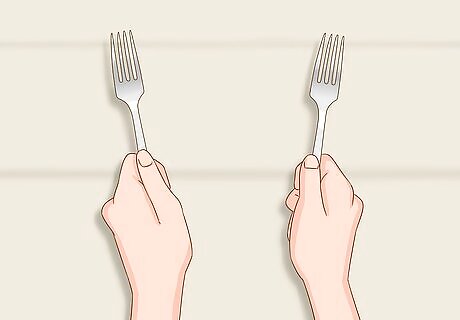
Hold your fork in your dominant hand. In most cases, you'll use whichever hand is most comfortable to pick up and hold your fork. However, there are some cultural differences you should be aware of. The type of meal you are eating may also affect your choice of hand. Take a look at these tips to help you choose which hand to hold the fork in: Europeans tend to keep the fork in their left hand throughout a meal. Americans will often hold the fork in their right hand while eating. If you don't need to observe table etiquette, hold the fork in whichever hand is most comfortable.
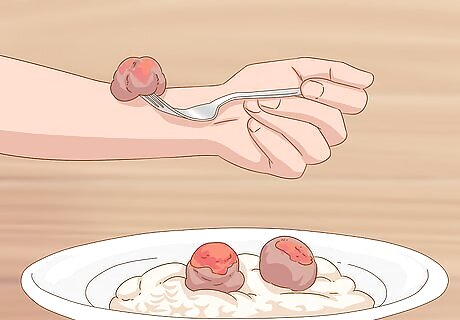
Hold the fork correctly while eating. Once you know which hand to pick the fork up with, you'll need to learn the proper way to hold it. Holding your fork properly will give you more control over it and allow you to observe good table manners. There are also two ways of holding your fork; the American method and the European style. Keep these steps in mind whenever you are picking up and holding a fork: To hold your fork in the European fashion, the end of the handle should be in the palm of your hand. Your pointer finger should be placed on the back of the fork, near the head of the fork. Your thumb will be placed on the outside edge of the fork handle. Grip the fork with the rest of your fingers, preventing it from dropping of shifting while in use. The tines of the fork should be pointing downwards in this style. To hold your fork in the American style, pick the fork up like you would hold a pencil. Hold the fork between your index and middle fingers, near the joint where the fork head meets the handle. Your thumb will go on top of the handle, resting about halfway up. The points of the fork will be pointing upwards, allowing you to stab or scoop food. Hold it up close to the top.
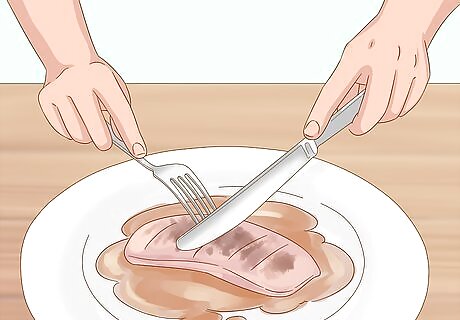
Know which hand to use while simultaneously cutting with a knife. There are two different ways to hold your fork while cutting with a knife; the American method and the European method. Knowing which method to use can help you observe proper local etiquette, make a good impression and enjoy your meal. Europeans will hold their fork in the left hand and their knife in the right hand. If you are eating in a European style dinner, do not switch hands during a meal. Always hold the fork in your left hand. When Americans are cutting food they will hold the fork in their left hand and the knife in their right. When Americans move to eat something with their fork, they switch hands and hold the fork in the right hand.
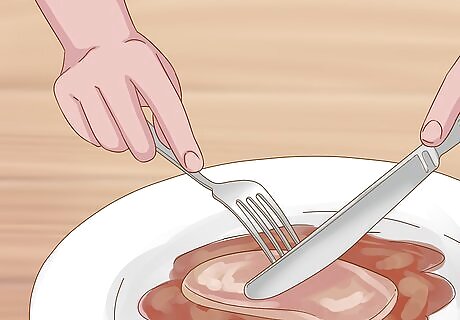
Hold the fork correctly while simultaneously cutting. You'll need to hold your food in place with the fork while cutting it. Pick up and hold the fork as you normally would, likely in your left hand. Place the prongs of the fork into the food you are cutting and hold it in place. With your opposite hand, pick up and hold knife in the same way you did with the fork and begin using it to cut your food. You'll be holding the fork in your left hand and the knife in your right hand. The handles of your fork and knife should rest against the palm of the hand holding them. The pointer fingers should be extended and will rest on the back side of your fork or knife.
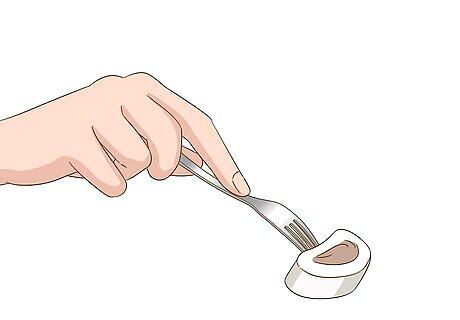
Stab the prongs into your food to take a bite. Once you've gotten a good handle on the fork, you can begin using it to eat. Find a piece of food that is a comfortable size to eat and bring the tines of the fork down into it. Apply just enough pressure to stick the food onto the tines of the fork. Make sure the food is secure and won't fall off the fork when you bring it towards your mouth.
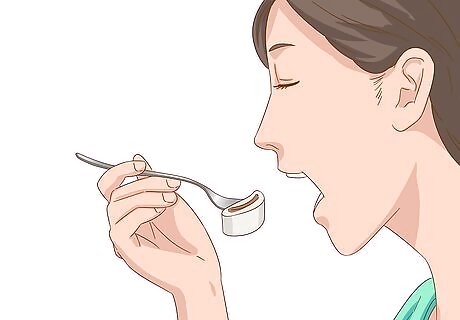
Bring the food into your mouth. Once you feel the food is secure, you can bring it up to your mouth and begin eating it. Move slowly and carefully as you take the food off of the fork with your mouth. If you aren't paying attention, you might miss your mouth, drop the food, make a mess, or even stab yourself. Once the food is near your mouth, use your teeth to gently remove it from the fork and enjoy.
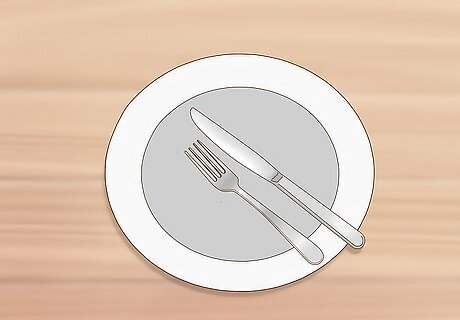
Know where to put your fork when you are finished with a bite, and when you are finished with the meal. You can let wait-staff know if you are done with your meal by placing your silverware in a specific position. Depending on how you put your silverware on your plate, you can indicate that you are still eating a dish or that you are ready to move onto the next. Keep these positions in mind when placing your silverware down between use: Americans will place their silverware at a "10 and 20" position. If the plate was a clock face, the points of the knife or fork will point to "10 o'clock", while the handle points to "20 minutes". In America, place your fork in the center of the plate and your knife above it, leaving a gap between the two. Make sure they are both in the "10 and 20" position to indicate that you are still enjoying the current course. When Americans are finished with a course, they remove the gap between their fork and knife, placing both in the upper right portion of their plates. Keep both the fork and knife in the "10 and 20" position. Europeans will cross their knife and fork in the lower portion of the plate to indicate they are still eating the current course. The points of the fork and knife should be facing away from you. In Europe, placing your utensils in the "10 and 20" position at the plate's center will indicate you are finished with that course.
Using the Right Fork
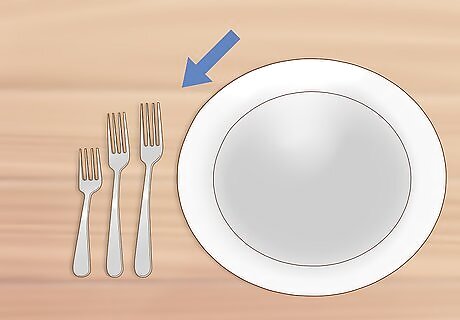
Look at the forks on the table. You may find that there are many different forks that have been set out before you at a dinner table. Each fork will have a specific use and time to use it during your meal. Knowing which fork to use and when to use it can be helpful, allowing you to enjoy your meal and make a good impression. Take a look at some of the different types of forks you might see: The largest fork is the dinner fork and it is used with the main course. Salad forks are usually the smallest fork at your table setting. Fish forks are slightly larger than the salad fork and slightly smaller than the dinner fork. Oyster forks are unique, having only two prongs. This fork will be placed with the spoons.
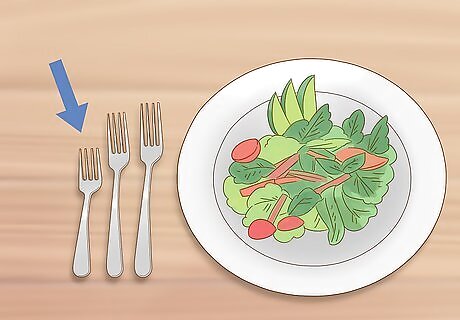
Pay attention to which course or meal you are eating. Each fork is provided for specific parts of a meal. Many of these forks will help you enjoy your meal, making it easier to pick the food up based on the fork's size and shape. Take a look at what type of food is being served to learn which fork you should be using. Generally, you will begin by using the fork on the outer left. Use the next fork to the right for each new course. Each course will likely require you to switch which fork you are using. If salad is being offered, make sure you are using the small salad fork. For the main course, it's safe to use the largest dinner fork.

Select the appropriate fork. Once you know which fork to use and when to use it, you can confidently make the right choice during a meal. Using the correct fork may seem like a small detail, but it can help make a good impression and allow you to demonstrate proper table etiquette. Always try to use the right fork during a meal. Remember to hold the fork properly. Use your left hand to hold whichever fork is appropriate. Pick the right fork for the right course.
Using Forks in Other Ways

Make a fork bracelet. Making a fork bracelet can be a simple and enjoyable project. Many forks even feature interesting designs on them, which can help make a fashionable bracelet. Try using these easy steps to create your own fork bracelet: Make a Fork Bracelet Find an old fork that you would like to use. Bend the fork into a bracelet shape. Bend the fork in the same direction that the tines are already bending. You may want to use pliers to get a better grip and more accurate bend. The fork's tines should be touching the butt of the fork's handle when finished. You can try painting the fork or decorating it however you want once it's bent into shape.
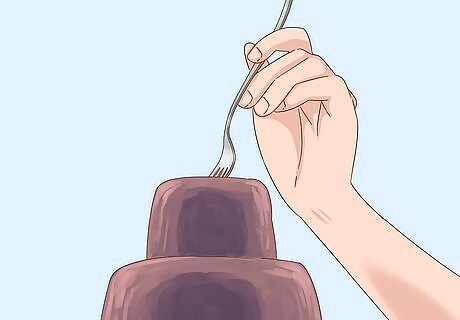
Use a fork while baking or cooking. Having a fork handy while baking and cooking is always a good idea. Some recipes will call for small holes to be made, to allow heat or air to escape. It can be fun to use a fork to make patterns in pie crust or frosting as well. Make sure you've always got a fork ready to help make cooking or baking a bit easier. Drag or press the fork tines in frosting to create unique designs. Pushing a fork into a pie crust or baked good can add a interesting look. Some recipes call for small holes to be made to prevent too much heat from building up. You can lightly stab the item with the fork to make these holes.
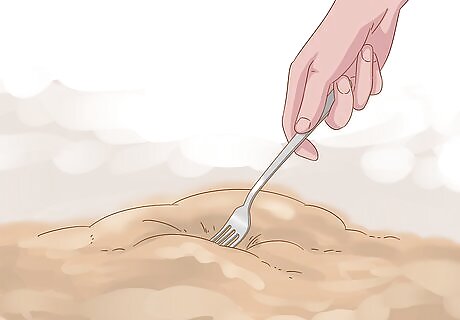
Plant seeds using a fork. Forks can be a simple tool to use in the garden, especially when planting seeds. Many seeds are very small, requiring you to make tiny spaces for them in the dirt. A fork is a great way to quickly make great planting spaces for your seeds. The next time you need to plant small seeds, try using an old fork to help make the job a bit easier. Forks with smaller tines are better suited to seed planting. Stab the fork into the dirt to make small holes for the seeds. Drop the seeds into the holes left by the fork tines and lightly cover them with dirt. Check the requirements for each type of seed you are planting. Some seeds like to be planted deeper than others.













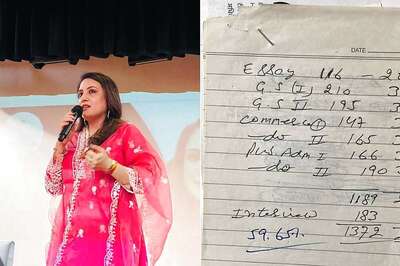



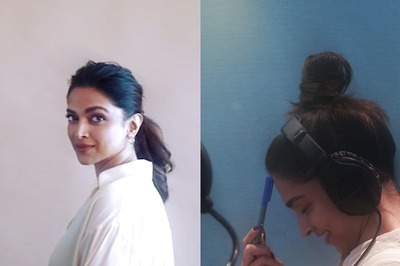

Comments
0 comment